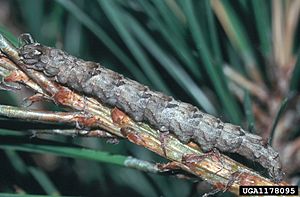Washed-out zale facts for kids
Quick facts for kids Washed-out zale |
|
|---|---|
 |
|
| Scientific classification | |
| Kingdom: | |
| Phylum: | |
| Class: | |
| Order: | |
| Family: | |
| Genus: |
Zale
|
| Species: |
Z. metatoides
|
| Binomial name | |
| Zale metatoides McDunnough, 1943
|
|
The Washed-Out Zale or Jack Pine False Looper (Zale metatoides) is a type of moth. It belongs to a big family of moths called Noctuidae. This moth was first discovered and named by a scientist named James Halliday McDunnough in 1943.
Contents
Meet the Washed-Out Zale Moth
The Washed-Out Zale moth is a fascinating insect. It gets its name from its appearance, which can look a bit faded. It is also sometimes called the Jack Pine False Looper because its caterpillars eat pine trees.
What Does It Look Like?
This moth is not very big. Its wingspan, which is how wide its wings spread from tip to tip, is about 35 millimeters. That's about the length of a standard paperclip! The caterpillars of this moth can be different colors. They are usually orange-brown, brown, or gray. Sometimes, you might even see greenish ones.
Where Does It Live?
You can find the Washed-Out Zale moth in specific types of places. It likes open, dry areas and forests filled with pine trees. Its home range stretches across North America. You can find it from places like Wisconsin and Manitoba in the north. It lives all the way east to Maine. It also flies south into the mountains of Georgia. Scientists are still learning exactly how far south it lives near the Gulf of Mexico.
Life Cycle
The Washed-Out Zale moth has one generation each year. This means that only one group of these moths grows up from eggs to adults in a single year.
What Does It Eat?
The caterpillars of the Washed-Out Zale moth are quite picky eaters. They mostly feed on different kinds of hard pine trees. Some of their favorite trees include jack pine, pitch pine, and red pine. They especially like to eat the fresh, new needles that grow on these young pine trees.

